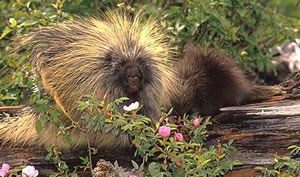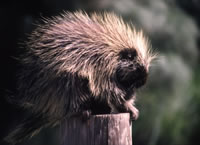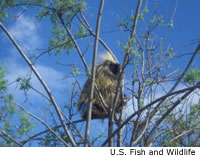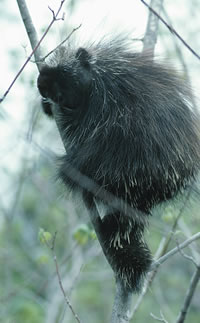 |
Canku Ota
|
 |
|
(Many Paths)
|
||
|
An Online Newsletter
Celebrating Native America
|
||
|
December 2014 - Volume
12 Number 12
January 2015 - Volume 13 Number 1 |
||
|
|
||
|
North American Porcupine
Erethizon dorsatum |
||
|
|

Characteristics
Characteristics The porcupine uses its quills for defense. The porcupine cannot shoot its quills. When a predator approaches, the porcupine will turn its back, raise the quills and lash out at the threat with its tail. If the porcupine hits an animal with its quills, the quills become embedded in the animal. Body heat makes the barbs expand and they become even more deeply embedded in the animal's skin. If an animal is hit in a vital place it may die. The porcupine is not an aggressive animal. It will only attack if it is threatened. Some animals, like the fisher, are experts at attacking porcupines. |
|||||||||||
 |
|
|
||
|
|
||
| Canku Ota is a free Newsletter celebrating Native America, its traditions and accomplishments . We do not provide subscriber or visitor names to anyone. Some articles presented in Canku Ota may contain copyright material. We have received appropriate permissions for republishing any articles. Material appearing here is distributed without profit or monetary gain to those who have expressed an interest. This is in accordance with Title 17 U.S.C. Section 107. | ||
|
Canku Ota is a copyright ©
2000 - 2014 of Vicki Williams Barry and Paul Barry.
|
||
 |
 |
|
|
The "Canku
Ota - A Newsletter Celebrating Native America" web site and
its design is the
|
||
|
Copyright ©
1999 - 2014 of Paul C. Barry.
|
||
|
All Rights Reserved.
|
||
 PorcupineThe
porcupine is a rodent. It has black to brownish-yellow fur and strong,
short legs. It has hairless soles on its feet that help it climb
trees. It has a round body, small ears and a small head. The most
recognizable feature of the porcupine is its quills. A porcupine
may have as many as 30,000 quills. The quills are hairs with barbed
tips on the ends. Quills are solid at the tip and base and hollow
for most of the shaft. The porcupine has quills on all parts of
its body, except for its stomach. The longest quills are on its
rump. The shortest quills are on its cheeks.
PorcupineThe
porcupine is a rodent. It has black to brownish-yellow fur and strong,
short legs. It has hairless soles on its feet that help it climb
trees. It has a round body, small ears and a small head. The most
recognizable feature of the porcupine is its quills. A porcupine
may have as many as 30,000 quills. The quills are hairs with barbed
tips on the ends. Quills are solid at the tip and base and hollow
for most of the shaft. The porcupine has quills on all parts of
its body, except for its stomach. The longest quills are on its
rump. The shortest quills are on its cheeks.  PorcupineThe
common porcupine can be found in most of Canada and the western
United States south to Mexico. In the eastern United States,
it can be found in Wisconsin, Michigan, Pennsylvania, New
York and New England.
PorcupineThe
common porcupine can be found in most of Canada and the western
United States south to Mexico. In the eastern United States,
it can be found in Wisconsin, Michigan, Pennsylvania, New
York and New England. PorcupineThe
common porcupine is an herbivore. It eats leaves, twigs and
green plants like skunk cabbage and clover. In the winter,
it may eat bark. It often climbs trees to find food. It is
mostly nocturnal, but will sometimes forage for food in the
day.
PorcupineThe
common porcupine is an herbivore. It eats leaves, twigs and
green plants like skunk cabbage and clover. In the winter,
it may eat bark. It often climbs trees to find food. It is
mostly nocturnal, but will sometimes forage for food in the
day. PorcupinePorcupines
mate in late summer and early fall. Porcupines are very vocal
during mating season. Males often fight over females. The male
performs an elaborate dance and sprays urine over the head of
the female. Seven months after mating the female gives birth
to a single baby. When the baby is born, its quills are soft.
They harden about an hour after birth. The baby is begins to
forage for food after only a couple of days. The baby will stay
with its mother for about six months.
PorcupinePorcupines
mate in late summer and early fall. Porcupines are very vocal
during mating season. Males often fight over females. The male
performs an elaborate dance and sprays urine over the head of
the female. Seven months after mating the female gives birth
to a single baby. When the baby is born, its quills are soft.
They harden about an hour after birth. The baby is begins to
forage for food after only a couple of days. The baby will stay
with its mother for about six months. PorcupineThe
common porcupine is a solitary animal, although it may den with
other porcupines in the winter. It makes its den in caves, decaying
logs and hollow trees. The common porcupine doesn't hibernate,
but it may stay in its den during bad weather. The common porcupine
is a good swimmer, its hollow quills help keep it afloat. It
is also an excellent tree-climber and spends much of its time
in trees. It is a very vocal animal and has a wide-variety of
calls including moans, grunts, coughs, wails, whines, shrieks
and tooth clicking.
PorcupineThe
common porcupine is a solitary animal, although it may den with
other porcupines in the winter. It makes its den in caves, decaying
logs and hollow trees. The common porcupine doesn't hibernate,
but it may stay in its den during bad weather. The common porcupine
is a good swimmer, its hollow quills help keep it afloat. It
is also an excellent tree-climber and spends much of its time
in trees. It is a very vocal animal and has a wide-variety of
calls including moans, grunts, coughs, wails, whines, shrieks
and tooth clicking.